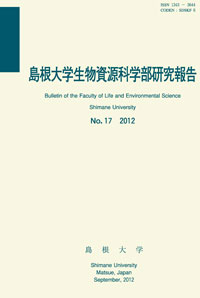島根大学生物資源科学部
ISSN:2435-0885(オンライン)
ISSN:1343-3644(冊子体)
なお、冊子体の刊行は23巻まで
ISSN:1343-3644(冊子体)
なお、冊子体の刊行は23巻まで

ダウンロード数 : ? 件
この文献の参照には次のURLをご利用ください : https://ir.lib.shimane-u.ac.jp/40645
島根大学生物資源科学部研究報告 22
2017-09-30 発行
ニホンジカの採食下にある弥山山地の埋土種子組成
The effects of browsing by sika deer on the species compositions of seed banks in the Misen Mountains
ファイル
内容記述(抄録等)
We used germination tests to evaluate the species compositions of soil seed banks (to depths of 5cm) in the Misen Mountains, Japan. We collected samples from a secondary pine forest (201), secondary oak forest(201), and primary laurel forest (201) ; sika deer browsed all three habitats. The dominant species in the seed banks (601) were Clethra barbinervis, Eurya japonica var. japonica, and Broussonetia monoica (woody plants) ; and Erigeron annuus and Hydrocotyle maritima (herbal plants). Seeds of many pioneer tree species were present, including Zanthoxylum ailanthoides, Mallotus japonicus, and Rhus javanica var. chinensis. The seed densities were 23.8 seeds/L (29 species/201 samples) in the pine forest, 14.3 seeds/L (18 species/201 samples) in the oak forest, and 21.7 seeds/L (32 species/201 samples) in the laurel forest. The herbal plant seed densities were 15.9 seeds/L (17 species/201 samples) in the pine forest, 5.9 seeds/L (11 species/201 samples) in the oak forest, and 15.0 seeds/L (15 species/201 samples) in the laurel forest. Thus, both the numbers of seeds and species were quite high, and included most common species. However, the seed banks of the oak forest were not as rich as were the other seed banks. Therefore, although we did not find that browsing by sika deer affected seed banks in the Misen Mountains, the seed banks should be monitored long-term.
About This Article
権利関係
島根大学生物資源科学部
Other Article
PP. 13 - 16
